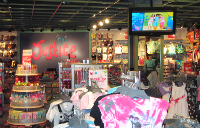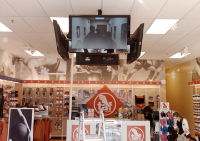
If you visit a Justice store, you may notice large plasma screens showing the latest video from Jonas Brothers.
When the song is over, an ad for an apparel or accessory item sold at the retailer targeting tween girls pops up, and then perhaps a 30-second spot for an upcoming movie release is aired.
You’re not watching MTV. You’re watching The Tween Network, an in-store video network launched earlier this year by Tween Brands in 600 of its Justice and Limited Too stores.
“We have found that it is a useful messaging tool for ourselves and our outside partners,” says Leslie Armour, founder of Youth Marketing Group, Tween Brands’ agency. “It allows brands, talent and products to have a voice. It brings them to life and gets customers asking about them.”
Tween Network aims to provide its core consumer with relevant, relatable, and aspirational lifestyle content. It includes a mix of entertainment — music, videos, movie trailers, celebrity shout outs and sneak peeks — with behind-the-scenes footage of its “catazine” shoots, marketing messages for store exclusives, sales, promotions and sweepstakes and commercials for the brand.
“There is no overload of any one thing,” Armour says. “We have seen a responsiveness to the messaging. There has been a lift in sales on the products that are promoted on the screen, and increased awareness and understanding of brands and products.”
Athletic footwear and apparel merchant TAF in February launched a retail video network. The in-store programming, branded as TAF TV, is part of parent company NexCen Brands’ rebranding of The Athlete’s Foot as TAF.
Like Tween Brands, TAF’s current rebranding initiative aims to engage customers on a more personal level. TAF TV plays a large role in executing this strategy.
The video network allows footwear and apparel vendors to play their latest advertising content in-store. The program content showcases new product and affiliated athletes in an entertaining format.
“TAF TV has a multitude of potential uses,” says Darius Billings, director of retail brand marketing and merchandising for NexCen Franchise Management, owner of TAF. “It aligns nicely with our rebranding goals in terms of modernizing the retail environment, but beyond that it also allows our vendors to connect with their customers.”
Sports Fitness Interactive handled the installation and management of the TAF TV network, and the technology came from software company Eyemagnet. Advertisers have the option of national or regional media buys, allowing them the ability to target and integrate messaging with other media channels, Billings says.
More than a digital billboard
Indeed, digital signage has evolved into much more than just electronic billboards, says Keith Kelsen, chairman/CEO of digital signage consulting firm 5th Screen and chair of the content committee for the Digital Signage Association.
With a combination of dynamic content that is highly adaptable to its audience and environment, high-definition video imagery and, in many cases, interactive features, digital signage can help retailers drive consumer behavior. But as with most technology, content is the key to success with digital signage, says Kelsen.
“Digital signage technology is complex, cutting-edge and still a work in progress.” But without the right content, delivered with a clear understanding of the power of the digital signage, all you’ll have is “a pile of technology,” says Kelsen.
“Those who understand how to create content that works for the digital signage will be the ones who will reap the benefits,” he adds.
Successful digital signage campaigns are measured by return on message, or ROM, says Kelsen. Based on the type of video network, key areas are measured differently.
Viewer metrics are also required: These include sales uplift, awareness, recall of message and action taken.
In addition to content, you need to understand refresh, relevancy and placement for a successful network. Refreshing is critical to keeping viewers engaged. “If the same content on the network is running for weeks or months without refresh, consumers will ignore it,” Kelsen says. “Refreshing the content based on the frequency of visits by the consumer will keep them interested and watching.”
The Tween Network videos are refreshed about every 30 days, Armour says. It’s a national program, so the content is the same in every store.
Getting started
So how does one go about setting up an in-store video network? Your strategy — and costs — will naturally depend on what you’re trying to accomplish with content, how many stores you have, and how many screens you need, says Kelsen.
First, consider your customer: Who is going to be viewing those screens? Based on that, you need to create the right content for the appropriate audience. Kelsen says this is where most merchants fail with their in-store video networks.
How do you do this right? Kelsen advises creating content that is a “solution sell” rather than a single-product sell. His client Home Depot Canada has driven sales with the solution-sell strategy.
For instance, the Canadian home improvement products retailer’s video content shows viewers how to do a bathroom-remodeling job, instead of just pushing the tools customers will need.
As for the technology and software, if you’re a 3,500-sq.-ft. shop, your needs will differ from a large department store. You may just need a few eye-level screens and a cellular network if you’re a boutique, while you might have to wire a mall anchor store that needs a few dozen screens.
Say you have a minimum of five smaller footprint mall stores. Kelsen says the cost just to set up a strategic blueprint and network guidelines can run you $5,000 to $25,000.

Adding a two-screen network on which the screens play separate content, plus the hardware, can cost from $4,000 to $6,000 per store.
The service fees and cellular connection range from $1,000 to $2,500 annually. Installation will run you another $450 to $600, plus the wall mounts cost about $300 each.
A staff teaching tool
In-store video signage is all about engaging the customer, but some retailers using the technology may find an added advantage: the ability to train staff remotely.
TAF TV enables store staff to receive product updates and technical information via the screen network, greatly reducing the vendors’ training costs. This distance-learning will ensure that information about the brands’ latest and most innovative products is top of mind with the highly influential staff, Billings says.
“The potential for distance learning is great,” Billings says. “We can use it is a training tool for new employees or for new product either before or after the store closes.”
Tween Network is also discussing using the video networks for distance learning purposes.
“In meetings with our stores managers, many of them have stated that they have used the content from product commercials to better educate themselves and the staff on particular products,” Armour says.
